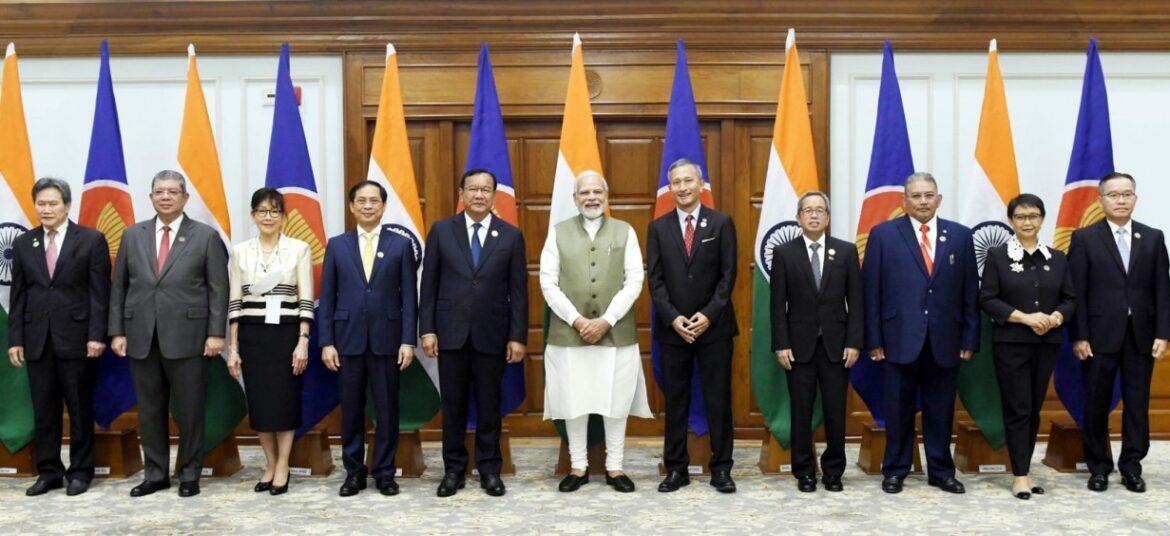Strap: A special meeting between foreign ministers of both regions will aid in peace and progress.

A joint vision of peace and progress, and shared prosperity endeavours are bringing India and ASEAN even closer. On the 30th anniversary of the ASEAN-India Dialogue, foreign ministers from both regions met to discuss opportunities for closer collaboration.
The agenda was to strengthen and deepen the ASEAN-India Strategic Partnership for mutual benefit. This included political, security, economic, socio-cultural, and development cooperation.
Officials from the participating countries discussed strategies to build an open and inclusive cooperation framework. Ease of doing business and simpler trade rules were part of the conversation. The larger mission was to build a regional partnership where countries work together to transform Southeast Asia socially and economically.
Highlights of the Indo-ASEAN Special Meeting: |
● Vision to improve peace, progress, and shared prosperity between India and ASEAN. ● Cooperation to reduce the development gap and alleviate poverty. ● Pledge to follow UN treaties on sea trade and regional cooperation. ● Effective implementation of the ASEAN-India Free Trade Area. ● Strengthen connectivity under India’s Act East Policy. ● Develop an interoperable digital connectivity ecosystem. ● Deeper cooperation for renewable energy and saving natural resources. |
Building connectivity
There is a rise in interdependence among ASEAN nations and India. To enable closer ties, the Special ASEAN-India Foreign Ministers’ Meeting emphasised bridging connectivity gaps through policies such as ASEAN’s MPAC 2025 and India’s Act East.
MPAC 2025 is the Master Plan for ASEAN Connectivity by 2025. The five pillars of this plan are sustainable infrastructure, digital innovation (open data, seamless logistics, regulatory excellence (trade ties), and people mobility (travel within the region).
In conjunction with MPAC, India’s Act East Policy focuses on cooperation between India and ASEAN on trade, transport, manufacturing, and infrastructure.
Early completion of existing projects was also on the agenda. This includes the completion and operationalisation of the India-Myanmar-Thailand Trilateral Highway. The Imphal-Moreh portion (in India) of the highway is expected to be completed in 2023. Once fully built, this route will enable faster trade.
The foreign ministers also expressed ambitions to extend this highway eastward to Lao PDR, Cambodia, and Vietnam. The comprehensive network will enable quicker movement of goods in Southeast Asia.
Moving forward
Most of ASEAN’s growth will be driven by urban centres. Close to 90 million additional people will move to urban areas in these countries by 2030. This means that there is a dire need to improve the standard of living in cities, reduce pollution, and decongest these spaces.
The Indo-ASEAN delegation agreed on closer collaboration on the ASEAN Smart Cities Network. This policy involves deploying technological and infrastructural solutions such as cybersecurity, a clean environment, public services, upskilling, and business incubators, among others.
Soon, a closer association between India and ASEAN will also be built on maritime and air connectivity. Instead of each country working on furthering its self-interest, the Indo-ASEAN partnership will mark a harmonious and symbiotic relationship between the member countries.

Sumit Dutta is the Founder and Chief Executive Officer of ASEAN Business Partners. Prior to this, Sumit spent 26 years working for HSBC, one of the biggest banks in the world, in countries including Indonesia, Vietnam, USA, Hongkong and India.
Stay up to update with our latest news.
Have Us Contact You
